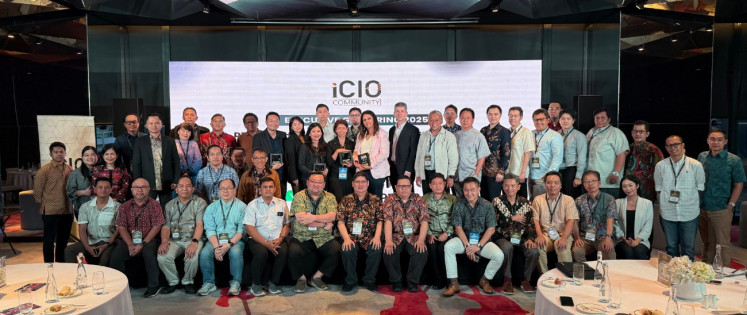Popular Reads
Top Results
Can't find what you're looking for?
View all search resultsPopular Reads
Top Results
Can't find what you're looking for?
View all search resultsSustainable rural spatial planning based on village autonomy
Two laws explicitly mention rural areas, namely Law No. 26/2007 on spatial planning and Law No. 6/2014 on villages. The Spatial Planning Law emphasizes that spatial planning in rural areas has to follow six principles.
Change text size
Gift Premium Articles
to Anyone
T
wo laws explicitly mention rural areas, namely Law No. 26/2007 on spatial planning and Law No. 6/2014 on villages. The Spatial Planning Law emphasizes that spatial planning in rural areas has to follow six principles. This notion, then, is translated into the Regional Spatial Plan. Rural areas are treated equally to urban areas, mining areas and others.
Meanwhile, the Village Law asserts that rural areas are shaped through a bottom-up process (village regulations and regional policies), covering matters related to the physical and non-physical infrastructure of the village. Physical infrastructure includes roads, electricity, telecommunications, markets, etc. Non-physical infrastructure includes technology in production and consumption, institutional cooperation between villages, and many other factors. Both of these are urgently needed to encourage development in rural areas.
In the context of rural sociology, rural development is a process of deliberate or conscious change to achieve physical and spiritual prosperity for all members of the rural community. Rural development covers all aspects of rural community life, such as economic, social, political, cultural, religious, defense and security aspects. In essence, rural development is a development process aimed at rural communities. Thus, it should differ from urban development. The aim of rural development is not to change the characteristics of rural communities from wesenwille and non-market economies to kurwille and market economies. Even though a change does occur, rural communities will not become a total market economies but rather a wesenwille with a hint of a market economy, a change caused by two elements: the intervention from the state and the sociocultural dimension of society.
Synergy in the development of rural areas is important for several reasons. First, rural development is an effort to improve the standard of living to achieve the welfare of the village, carried out in combination with development efforts based on the region’s potential. Therefore, the concept of rural areas in Law No. 6/2014 on villages, in which rural areas function for agriculture and management of natural resource, must synergize with the Regional Spatial Plan. Second, it is important for the government to provide and synergize the documents of rural development planning with Regional Spatial Planning documents.
Historically, all local communities in Indonesia have strong local wisdom that contains a spirit of sufficiency, balance and sustainability, especially in managing natural and human resources. They also have local wisdom that regulates matters concerning the government, resource management, interpersonal relationships and so on. In principle, these local regulations are intended to maintain balance and sustainability in human relationships with fellow humans, nature and God. Meanwhile, from a philosophical perspective, it is clear that the village exists before the government. Therefore, the village should be the basis and part of the government that comes after. The older, more experienced government in the village should spearhead every implementation of government, development and societal affairs.
As part of national ideals, efforts to strengthen regional and “village autonomy” aim to build a strong and perfect imagination of Indonesia that goes beyond centralism and localism. Indonesia will be stronger if it is supported by the sovereignty of the people and local independence (of the region and village). In other words, the center “respects” the local while the local “respects” the center. The independence of the village is the key to the foundation, strength and imagination of Indonesia. If the village remains marginal and dependent, it will just become a heavy burden on the government. Furthermore, it will disrupt the foundation of Indonesia. In the future, we need the village as a local entity that possesses strong and unique characteristics, political sovereignty, economic empowerment, and cultural dignity.
Independence means village autonomy. Village autonomy has objectives and benefits as follows:
- Strengthening the independence of the village as the basis of Indonesian independence;
- Strengthening the village’s position as the subject of development;
- Familiarizing the community with development planning;
- Improving public services and implementing equitable development;
- Creating efficient development financing per local needs;
- Stimulating the local economy and the livelihoods of the village communities;
- Giving trust, responsibility and challenges to the village to increase its initiatives and potential;
- Forging village capacity in managing the government and development;
- Providing a valuable learning arena for the village government, institutions and communities; and
- Encouraging local communities’ participation.
The regulation on village autonomy is a response to the globalization, which is characterized by the liberalization of information, economy, technology, culture and so on. As such, there must be a rational division of tasks and authority in the state and society so that each can carry out their functions. There is a basic principle that people must adhere to in executing the division of tasks and authority, which is imagining the regions and villages as a flexible part within an entity called a state. A politically sovereign, economically empowered and culturally dignified village becomes the ideal and local foundation to strengthen the nation-state. The village government’s authority is in village-based spatial planning in rural areas through the principle of recognition and subsidiary, in the form of authority to establish rural areas following village initiatives to the village government through the village regulation.
Ni Made Jaya Senastri, lecturer in postgraduate law studies at Warmadewa University










